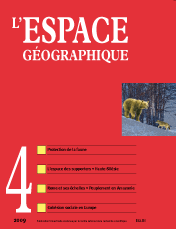

Protection of large wildlife and territories: two management models in the Cantabrian Mountains (9 fig.)
The coexistence of predators and livestock frequently causes social tensions. The geographical conditions of this cohabitation are examined in the Cantabrian Mountains, where protection of natural areas is less strict than in France. In Asturias, a model controlled by the public authorities allows bears and wolves to survive through subsidies paid to graziers and regulation by hunting in protected areas. In León, wolves are still a hunted species and the losses to livestock they cause are compensated by revenues from hunting. These two systems might offer ideas for the French system overcome its obvious limitations.
keywords: CANTABRIAN MOUNTAINS, FAUNA, GRAZING, HUNTING, PROTECTED AREA
Urbi et orbi: Rome’s urban trajectory and the interplay of scales (3 fig., 1 tabl.)
This article brings together the Eternal City and the concept of scale, considered from a constructivist perspective. It presents the Roman spatial system, characterized by the combination of a micro-regional and a macro-regional scale and by an interplay of time scales (the ‘‘compression method’’). It indicates that the centre of the Catholic Church has played an important but ambiguous role in the construction of the global, national and European scales. The article examines the diversity of interactions between different scales in a world city. The case study encourages moving beyond the traditional reference to changing scales towards a geopolitical analysis of scales.
keywords: GLOBALISATION, RELIGION, SCALE, SYSTEMIC, TIME
From discontinuity to interconnection: rail networks, borders, and metropolitan development in Upper Silesia (2 fig., 2 photos, 1 tabl.)
This paper addresses the issue of the development and promotion of borders. It focuses on the discontinuity near the conurbation of Katowice resulting from the juxtaposition of two rail networks with different gauges. The network border causes a break of gauge between the railroads, but since the construction of a rail junction, the situation has changed and the discontinuity is now becoming a transit area. This merge point has become an multimodal transport hub, linking the railroads of Europe and Asia. This logistics hub is playing a key role in the construction of a metropolitan area in Upper Silesia.
keywords: BORDER, METROPOLIS, RAIL CONNECTOR, RAIL NETWORK, UPPER SILESIA
encadré, 7 fig., 1 tabl.)
The paper tackles the social aspect of territorial cohesion through an examination of public service accessibility, a topic which requires an approach on a local scale. It presents the conceptual problems and methodological implications that this type of research on a European scale creates. Service areas are delimited according to three conceptual bases: accessibility, supply and demand. Based on an application of fuzzy sets theory, the method is applied to maternity hospitals in the Greater Region (a border territory composed of Lorraine, Luxembourg, Rheinland-Pflaz, Saarland and Wallonia) . The resulting map of the three prospective scenarios developed in ESPON 3.2. shows the consequences of political decisions on planning and territories.
keywords: ACCESSIBILITY, FUZZY LOGIC, GREATER REGION (FORMERLY SAARLORLUX), PUBLIC SERVICE, TERRITORIAL COHESION
Football territories: the space of ‘‘remote supporters’’ (5 fig.)
Football fandom seems to be redefining the relationship to territory: fans of football clubs can belong to social networks disconnected from the geographical and cultural affiliations of the majority of members. ‘‘Remote supporting” reveals the complexification of sports identification processes and their gradual disconnection from experiences of conflict and emotion, felt in a local or national context. By remodelling the ‘‘space of football’’, this trend provides insights into forms of community feeling, ‘‘elective identities’’ and the construction of trans-territorial social networks in the contemporary world.
keywords: FOOTBALL, IDENTITY, SOCIAL NETWORK, SPACE, TERRITORY
Location of the population in the Brazilian Amazon: a more precise picture working at the census block level (6 fig, 2 tabl.)
Studying data from the 2007 partial census of Brazil, published at the block level, this paper proposes an approach to the distribution of the population in the Brazilian Amazon. The analysis is based on simple questions: “How many people live in the Amazon?”, “How many people live in the rainforest?” or “Do people in the Amazon live predominantly in deforested areas?”. The first section of the article presents the data and methods used, as well as the implications of the issue. The second section shows some results extracted from the 2007 data. The third section crosses data from the census with data from other geographical coverage, in particular the map of the deforested areas of the Amazon.
keywords: AMAZON, CENSUS, GIS, REGIONAL GEOGRAPHY
Book reviews
In this issue of l’Espace géographique, you will find critical reviews of the following books
DEPRAZ S. (2008). Géographie des espaces naturels protégées: genèse, principes et enjeux territoriaux. Paris: Armand Colin, coll. «U. Géographie», 320 p. (Yves Poinsot, université de Pau)
DUBOIS S. (2008). La Révolution géographique en Belgique. Départementalisation, administration et représentations du territoire de la fin du XVIIIe au début du XIXe siècle. Bruxelles: Académie royale de Belgique, 335 p. (Nicolas Verdier, université de Pau)
HÉRITIER S., LASLAZ L. (2008). Les Parcs nationaux dans le monde: gestion et développement durable. Paris: Ellipse, coll. «Carrefours. Les Dossiers», 312 p. (Yves Poinsot, université de Pau)
L’espace géographique 3/09![]()
![]() L’espace géographique 1/10
L’espace géographique 1/10
For subscribe or buy this issue: BELIN
![]() L’Espace géographique: contents
L’Espace géographique: contents
Last modified: May 31, 2010